导则修订2
特殊环境条件 选用导则 第2部分:高分子材料-最新国标

特殊环境条件 选用导则 第2部分:高分子材料1 范围本文件给出了对干热、干热沙漠、高原、湿热海洋、湿热、极端寒冷等6种特殊环境条件下高分子材料的选用提出选用导则。
本文件适用于塑料、橡胶、涂料,其中塑料包括生物降解塑料和非生物降解塑料。
2 规范性引用文件下列文件中的内容通过文中的规范性引用而构成本文件必不可少的条款。
其中,注日期的引用文件,仅该日期对应的版本适用于本文件;不注日期的引用文件,其最新版本(包括所有的修改单)适用于本文件。
GB/T 20625 特殊环境条件 术语3 术语和定义GB/T 20625界定的术语和定义适用于本文件。
4 高分子材料的分类本文件所涉及的高分子材料主要包括塑料、橡胶、涂料等3类,其中塑料包含生物降解塑料和非生物降解塑料。
5 使用环境条件使用环境分为6种类型,干热、干热沙漠、高原、湿热海洋、湿热和极端寒冷等室内外环境。
6 使用环境对高分子材料的要求干热、干热沙漠环境用的高分子材料宜选用耐高温、耐低温和耐温变性均良好的材料。
高原地区用的高分子材料宜选用对紫外线不敏感的材料,其次可选用添加了紫外线吸收剂的材料。
湿热海洋、湿热环境使用的高分子材料宜选用耐生物降解、分子主链极性低的材料。
极端寒冷环境使用的高分子材料宜选用低温韧性大的高分子材料。
7 高分子材料种类的选择塑料种类的选择特殊环境条件下,常用的非生物降解塑料参见附录A,常用的生物降解塑料参见附录B。
橡胶种类的选择特殊环境条件下,常用的橡胶材料参见附录C。
涂料种类的选择特殊环境条件下,金属表面涂料种类的选择见GB/T 20644.1-202X。
8 试验评价项目的选择特殊环境条件下,高分子材料评价项目的选择见表1。
表1 高分子材料评价项目项目类型 项目名称力学性能 拉伸强度、断裂伸长率、弯曲强度、撕裂强度、缺口冲击强度、落球冲击强度表观性能 光泽、颜色、粉化、裂纹、变形、硬度、是否有析出物、表面是否发粘光学性能a透光率、雾度、折射率、双折射率电学性能 介电强度、介电常数、介电损耗角正切、表面电阻率、体积电阻率、耐电弧 生物降解性能b生物降解率、崩解率a仅适用于透明或半透明高分子材料。
生态影响评价导则2022版解析

• 工程占用、施工活动干扰、环境条件改变、 时间或空间累积作用等,直接或间接导致物
种、种群、生物群落、生境、生态系统以及
变化 自然景观、自然遗迹等发生的
。生态
影响包括直接、间接和累积的影响。
• 3.2重要物种 important species • 在生态影响评价中需要重点关注具有较高保
护价值或保护要求的物种,包括国家及地方
实质上就是基本工作程序和内容!
• 4.2 基本要求 (3条。熟悉)
• 4.2.1 建设项目选址选线应尽量避让各类 生态敏感区,符合自然保护地、世界自然遗
产、生态保护红线等管理要求以及国土空间规 划、生态环境分区管控要求。
• 4.2.2 建设项目生态影响评价应结合行业特 点、工程规模以及对生态保护目标的影响 方式,合理确定评价范围,按相《中华人民共和国环境保护法》《中华人民 共和国环境影响评价法》和《建设项目环境保护管 理条例》,规范和指导生态影响评价工作,防止生 态破坏,制定本标准。
• 本标准规定了生态影响评价的一般性原则、工
作程序、内容、方法及技术要求。
• 本标准是对《环境影响评价技术导则 非污染生态影
保护目标就是“对象”! 实际报告编写中很多人弄不明白 保护目标,将保护目标与“评价
标准”弄混了。
4总则
• 4.1 基本任务 • 在工程分析和生态现状调查的基础上,识别
、预测和评价建设项目在施工期、运行期以 及服务期满后(可根据项目情况选择)等不 同阶段的生态影响,提出预防或者减缓不利 影响的对策和措施,制定相应的环境管理和 生态监测计划,从生态影响角度明确建设项 目是否可行。
响》(HJ/T 19—1997)的第二次修订,第一次
修订版本为《环境影响评价技术导则 生态影响》( HJ 19—2011)。本次修订的主要内容有:
危险化学品事故应急救援预案编制导则范本(二篇)

危险化学品事故应急救援预案编制导则范本1.范围本导则规定了危险化学品事故应急救援预案编制的基本要求。
本导则适用于___境内危险化学品生产、储存、经营、使用、运输和处置废弃危险化学品单位(从业单位)。
2.规范性引用文件下列文件中的条文通过在本导则的引用而成为本导则的条文。
凡是注日期的引用文件,其随后所有修改(不包括勘误的内容)或修订版均不适用本导则,同时,鼓励根据本导则达成协议的各方研究是否可使用这些文件的最新版本。
凡是不注日期的引用文件,其最新版本适用于本导则。
《___安全生产法》(___第___号)《___职业病防治法》(___第___号)《___消防法》(___第___号)《危险化学品安全管理条例》(___第3___号)《使用有毒物品作业场所劳动保护条例》(___第3___号)《特种设备安全监察条例》(___第3___号)《危险化学品___》《___化学品目录》《化学品安全技术说明书编写规范》(GB16483)《重大危险源辨识》(GB18218)《建筑设计防火规范》(GBJ16)《石油化工企业设计防火规范》(GB50160)《常用化学危险品贮存通则》(GB15603)《原油和天然气工程设计防火规范》(GB50183)《企业职工伤亡事故经济损失统计标准》(GB6721)3定义3.1化学品指各种化学元素、由元素组成的化合物及其混合物,无论是天然的或人造的。
3.2危险化学品指化学品中具有易燃、___、有毒、有害及有腐蚀特性,对人员、设施、环境造成伤害或损害的化学品。
3.3事故指人类在进行有目的的活动过程中,发生了违背人意愿的且表现出不利于实现目的的现象。
3.4危险化学品事故指由一种或数种危险化学品或其能量意外释放造成的人身伤亡、财产损失或环境污染事故。
3.5直接经济损失指因事故造成人身伤亡及善后处理支出的费用和毁坏财产的价值。
3.6间接经济损失指因事故导致产值减少、资源破坏和受到事故影响而造成其他损失的价值。
危险化学品安全评价导则(2篇)

危险化学品安全评价导则范围本标准规定了危险化学品经营单位(以下简称经营单位)安全评价的前提条件、程序、内容和要求。
本标准适用于对危险化学品经营单位的安全评价。
引用标准下列标准所包含的条文,通过在本标准中引用而构成本标准的条文。
本标准在出版时,所示版本均为有效。
所有标准都会被修订,使用本标准的各方应探讨使用下列标准最新版本的可能性。
GBJ16-87(xx年版)《建筑设计防火规范》GB15603-xx《常用化学危险品贮存通则》GB18265-xx《危险化学品经营企业开业条件和技术要求》国务院令第344号《危险化学品安全管理条例》国家经贸委令第36号《危险化学品经营许可证管理办法》国家安全生产监督管理局《关于〈危险化学品经营许可证管理办法〉的实施意见》劳部发[xx]56号《爆炸危险场所安全规定》公安部令xx年4月10日第6号《仓库防火安全管理规则》安全评价的前提条件3.1经营单位应持有工商行政管理部门核发的营业执照,其营业执照上的企业名称、经营范围应与其向安全评价机构提交的的《危险化学品经营单位基本情况表》(见附录B)相一致。
2新设立的经营单位应持有相关部门批准的文件,新项目应有竣工验收批准文件,其批准文件上的企业名称、经营范围应与其向安全评价机构提交的的《危险化学品经营单位基本情况表》相一致。
3.3租用场地、设施经营危险化学品的单位应持有租赁合同,其租赁合同上的企业名称、经营范围应与其向安全评价机构提交的的《危险化学品经营单位基本情况表》相一致。
安全评价的基本内容4.1《危险化学品安全管理条例》第二十八条规定的经营单位必须具备的条件。
4.2国家经贸委令第36号《危险化学品经营许可证管理办法》第六条规定的经营单位应具备的基本条件。
4.3国家安全生产监督管理局《关于〈危险化学品经营许可证管理办法〉的实施意见》四规定的经营单位基本条件。
安全评价程序5.1前期准备工作5.1.1根据被评价单位的委托书,索取本标准3所列被评价单位的营业执照或相关批准文件、租赁合同复印件,以及《危险化学品经营单位基本情况表》。
北京CBD核心区城市设计导则 第二篇

步行街
第二篇 CBD核心区总体控制性要求
G-1
东 三 环 北东 路三 环 北 路
G-2
国
贸 桥
G-3
国 贸 桥
北京CBD核心区城市设计导则
光华路
G-4
Z-16
景辉街
金
金
和
和
路
G-5
东
路
景辉南街
G-6
建国路
Z-14-2
针 织 路
- 73 -
地面建筑衔接
功能说明
1.实现不同建筑在空中的联系,核心区域内长距离步行时,减 少行人由于反复进出建筑、上下楼梯形成的无效交通。 2.与建筑内部通道相结合,提供良好的全天候行人通行环境 (遮荫、避雨、防风等)。 3.实现空中、地面、地下多层次、相互及各自均连续的行人系 统。 4.连廊净宽≥6米。
3.Z-7北侧及Z-5、Z-6南侧应各退用地红线7米, 预留地铁站快速通道。通道两侧应再退5.5米作为 商业面积。
5
Z14-2
4.建议二级地块沿地铁站快速通道、交通大厅设
置带状商业面积。
5.从公共通道进入二级地块商业区域应设置人行 接口,以便消防安全疏散。
Z16
Z7
连接R1和10号线换乘通道
北京CBD核心区城市设计导则
第三类退线:城市支路沿线的退线。
1.景辉街沿线退用地红线5米。景辉南街沿线,Z-8、Z-9、 Z-10、Z-11退用地红线5米。Z-5、Z-6、Z-7、中服地块退用地 红线17.5米。 2.金和路和金和东路沿线(除Z-15和文化设施用地以外)首层 退用地红线10米,其余各层退用地红线5米。Z-15为500米超高 层地标,退用地红线15米。
连廊构成
1.建筑内部公共通道(走廊)。 2.建筑之间连廊(通过建筑内部楼、扶梯与地面层联系),可 直接进入建筑内部。 3.兼有行人过街天桥功能的连廊(就近设置建筑楼、扶梯,或 另外增设楼、扶梯,便于行人在连廊与地面人行道之间的往 来)。
交流架空输电线路绝缘子使用导则第2部分
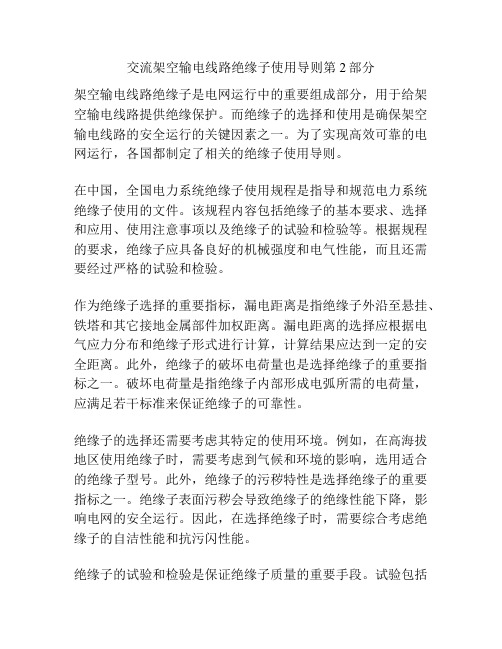
交流架空输电线路绝缘子使用导则第2部分架空输电线路绝缘子是电网运行中的重要组成部分,用于给架空输电线路提供绝缘保护。
而绝缘子的选择和使用是确保架空输电线路的安全运行的关键因素之一。
为了实现高效可靠的电网运行,各国都制定了相关的绝缘子使用导则。
在中国,全国电力系统绝缘子使用规程是指导和规范电力系统绝缘子使用的文件。
该规程内容包括绝缘子的基本要求、选择和应用、使用注意事项以及绝缘子的试验和检验等。
根据规程的要求,绝缘子应具备良好的机械强度和电气性能,而且还需要经过严格的试验和检验。
作为绝缘子选择的重要指标,漏电距离是指绝缘子外沿至悬挂、铁塔和其它接地金属部件加权距离。
漏电距离的选择应根据电气应力分布和绝缘子形式进行计算,计算结果应达到一定的安全距离。
此外,绝缘子的破坏电荷量也是选择绝缘子的重要指标之一。
破坏电荷量是指绝缘子内部形成电弧所需的电荷量,应满足若干标准来保证绝缘子的可靠性。
绝缘子的选择还需要考虑其特定的使用环境。
例如,在高海拔地区使用绝缘子时,需要考虑到气候和环境的影响,选用适合的绝缘子型号。
此外,绝缘子的污秽特性是选择绝缘子的重要指标之一。
绝缘子表面污秽会导致绝缘子的绝缘性能下降,影响电网的安全运行。
因此,在选择绝缘子时,需要综合考虑绝缘子的自洁性能和抗污闪性能。
绝缘子的试验和检验是保证绝缘子质量的重要手段。
试验包括类型试验、例行试验和特殊试验等。
类型试验是根据绝缘子型号进行的一次性试验,包括电气性能试验、机械性能试验和环境试验等。
例行试验是根据绝缘子生产的一般情况进行的批量试验,用于验证绝缘子的质量稳定性。
特殊试验是根据特殊需求进行的个别试验,例如抗污闪特性试验和抗灼烧试验等。
综上所述,架空输电线路绝缘子使用导则的第二部分主要涵盖了绝缘子的基本要求、选择和应用、使用注意事项以及绝缘子的试验和检验等内容。
绝缘子的选择和使用对于确保架空输电线路的安全运行至关重要,因此遵循相关导则并进行合理的选择和检验是非常必要的。
环境影响评价技术导则 大气环境(HJ2.2-2018)解读
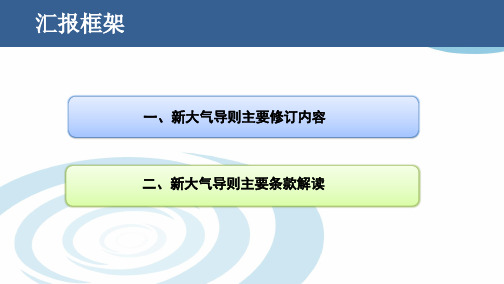
8、大气环境影响预测与评价 9、环境监测计划
11、大气环境影响评价结论与建议 10、大气环境影响评价结论与建议
2008版导则
附录 A 推荐模式清单 B 估算模式所需参数及说明 C 报告书附图、附表及附件要求
2018版导则
A 推荐模型清单 B 推荐模型参数及说明 C 大气环境影响评价基本内容与图表 D 其他污染物空气质量浓度参考限值
汇报框架
一、新大气导则主要修订内容
二、新大气导则主要条款解读
修订背景
2015年6月,环保部开展“环评和监测工作创新讨论”:提高导则
重构环评技术导 则体系
规范的指导性和适用性,增强环评的针对性和科学性 2015年9月,环保部评估中心提出“重构环境影响评价技术导则体 系工作方案” 2016年12月,《新总纲HJ2.1-2016》发布。进一步优化环评文件
7.1 调查内容 特殊项目评价等级判定 5.3 评价等级判定 现状调查重点关注哪些污染源
包括项目污染源调查和区域污染源调查
• 建设项目环评污染源调查:源强核算技术指南、排污 许可,结合工程分析从严确定
明确:区域替代、削减、以新带老、总量来 源 重点关注现状监测值不能反应其污染影响及 变化的污染源(包括被替代污染源、区域在 建、已批复的拟建项目) 监测期间已经存在且正常排放的污染源不用 做详细调查
• 规范大气环境影响评价结果及结论,满
足排污许可证制度与环境影响评价有效
衔接的管理需要
汇报框架
二、新大气导则主要条款解读
条款解读——1~4
1、适用范围
适用于建设项目大气环境影响评价 规划环评的大气影响评价参照使用
2、规范性引用文件
新增:HJ663环境空气质量评价技术规范(试行)、 HJ819排污单位自行监测技术指南 总则 删除:TJ36-79
火电厂汽水化学导则 第2部分:锅炉炉水磷酸盐处理
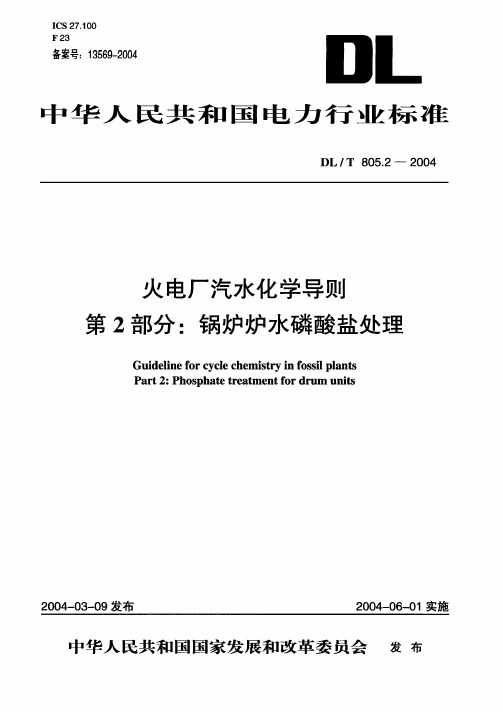
平衡磷酸盐处理 (P ) qi r m o htt a et E T u bi p s a r t n e l u h p e m i e 维持炉水中磷酸三钠含量低于发生磷酸盐隐藏现象的临界值,同时允许炉水中含有不超过 lg m几
1
DL 0 . 一 2 0 / 8 52 T 04
性磷酸盐腐蚀;
c 采用L 和ET时 T P 锅炉发生磷酸盐隐藏的程度会减轻或消除,锅炉很少发生酸性磷酸盐腐蚀。 ) P
44 T C T L T和 E Z的使用条件 . P , , P P P,
见表 l a
表1 T C T L T P P , , 和E T的使用条件 P P
注1 :协调p - H 磷酸盐处理包含国外所称等成分磷酸盐处理,在我国统称协调p - H 磷酸盐处理。
注2 :为了防止发生酸 性磷酸盐腐蚀,将N+ O a 与P 幸的摩尔比由 原来的2 - .提高到2 3 0 .2 3 8 . . 6 0
34 .
低磷酸盐处理 ( P ) l p op ae am n L T o hshtt t et w r e 为了防止炉内生成钙镁水垢和减少水冷壁管腐蚀,向炉水中加入少量磷酸三钠的处理。
32 .
磷酸 理 (T o htta e 盐处 P ) hs a r t n p p e m t e
为了防止炉内生成钙镁水垢和减少水冷壁管腐蚀,向炉水中加入适量磷酸三钠的处理。
33 .
协调p - H 磷酸盐 处理 (P ) og e po ht r te C T nr n hs a ta n c u t p e m t e 为了 止炉 产生游 氢氧化 维 a O 的 防 水 离 钠, 持N+ 幸 摩尔比 . 3 的 酸盐 与P 为2- . 磷 处理。 6 0
压载水取样导则(G2)
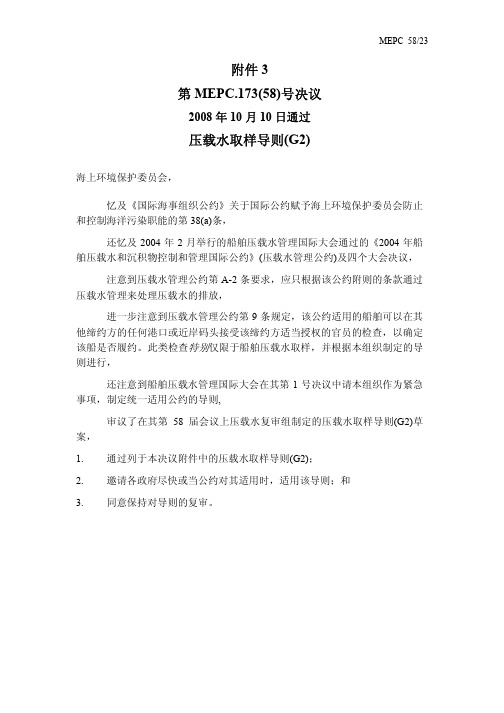
进一步注意到压载水管理公约第 9 条规定,该公约适用的船舶可以在其 他缔约方的任何港口或近岸码头接受该缔约方适当授权的官员的检查,以确定 该船是否履约。此类检查特别仅限于船舶压载水取样,并根据本组织制定的导 则进行,
放造成的附加影响。
MEPC 58/23 ANNEX 3 Page 5
6.4 在紧急情况下或爆发传染病时,港口国可以使用替代的取样方法,但需 要公布一个简短的通知,并尽力通告进入其管辖区的船舶。虽然在这种情况下 该国可能不需要通知海事组织,但此类通知对于其他当事国是有益的。
6.5 根据上述的 6.4 段而使用的替代取样措施,应对压载水公约第 12 条的要 求给与应有的注意。
这样的取样会得到过高或过低的生物密度估值。
5.4 舱内取样应仅用于压载水在舱内或之前进行了压载水处理的情况。如压 载水处理的任何过程是在压载水排放期间进行,则舱内取样是不合适的。
5.5 考虑到这些可能存在的不利情况,D-2 标准符合性检查的取样,应尽实 际可能地在排放管路中靠近排放点的位置进行。
5.6 一个例外的情况是,当通过直接舷外排放阀排空,如上边舱,而不使用 压载泵时,舱内取样是合适的方法。
/ml;且
.3
指标微生物的排放不得超过:
MEPC 58/23 ANNEX 3 Page 3
(i)
有毒霍乱弧菌(O1 和 O139)少于 1 菌落形成单位(cfu)
/100ml 或小于 1 cfu/g 浮游动物样品(湿重);
(ii) 大肠杆菌:少于 250 cfu/100ml;及
(iii) 肠道球菌:少于 100 cfu/100ml。
英文 Directives-Part2 ISOIEC导则 第2部分:国际标准结构及编写规则

ISO/IEC Directives, Part 2 Directives ISO/CEI, Partie 2Rules for the structure and drafting of International StandardsRègles de structure et derédaction des Normes internationalesFifth edition, 2004© ISO/IECInternational Organization for Standardization1, rue de VarembéCase postale 56CH-1211 Geneva 20 Telephone: +41 22 749 0111 Telefax: +41 22 733 3430 E-mail: central@ Web: International Electrotechnical Commission 3, rue de VarembéCase postale 131CH-1211 Geneva 20Telephone: +41 22 919 0211Telefax: +41 22 919 0300E-mail: inmail@iec.chWeb: http://www.iec.ch© ISO/IEC 2004All rights reserved. It is permitted to download this electronic file, to make a copy and to print out the content for the purpose of preparing ISO and IEC documents only. You may not copy or “mirror” the file, or any part of it, for any other purpose without permission in writing from the publishers.Corrected 2004-12-21© ISO/IECCONTENTS Foreword (5)Introduction (6)1Scope (7)2Normative references (7)3Terms and definitions (8)4General principles (10)4.1Objective (10)4.2Performance approach (10)4.3Homogeneity (10)4.4Consistency of documents (11)4.5Equivalence of official language versions (11)4.6Fitness for implementation as a regional or national standard (12)4.7Planning (12)5Structure (12)5.1Subdivision of the subject matter (12)5.2Description and numbering of divisions and subdivisions (15)6Drafting (17)6.1Preliminary informative elements (17)6.2General normative elements (19)6.3Technical normative elements (20)6.4Supplementary informative elements (25)6.5Other informative elements (25)6.6Common rules and elements (26)6.7Aspects of conformity assessment (40)6.8Aspects of quality management systems, reliability and sampling (40)7Preparation and presentation of documents (41)Annex A (informative) Principles for drafting (42)A.1General principles (42)A.2The aim-oriented approach (42)A.3The performance approach (43)A.4The principle of verifiability (44)A.5Choice of values (44)A.6Accommodation of more than one product size (45)A.7Avoidance of repetition (45)Annex B (informative) Basic reference works (46)B.1Introduction (46)B.2Reference works for language (46)B.3Standardized terminology (46)B.4Principles and methods of terminology (46)B.5Quantities, units and their symbols (46)B.6Abbreviated terms (47)B.7Bibliographic references (47)B.8Technical drawings (47)B.9Technical documentation (47)B.10Graphical symbols (47)B.11Limits, fits and surface properties (48)© ISO/IECB.12Preferred numbers (48)B.13Statistical methods (48)B.14Environmental conditions and associated tests (48)B.15Safety (48)B.16Chemistry (48)B.17EMC (electromagnetic compatibility) (48)B.18Conformity and quality (49)B.19Adoption of International Standards (49)B.20Environmental management (49)Annex C (informative) Example of numbering of divisions and subdivisions (50)Annex D (normative) Drafting and presentation of terms and definitions (51)D.1General principles (51)D.2Independent terminology standards (52)D.3Presentation (53)Annex E (normative) Drafting of the title of a document (56)E.1Elements of the title (56)E.2Avoidance of unintentional limitation of the scope (57)E.3Wording (57)Annex F (normative) Patent rights (58)Annex G (normative) Designation of internationally standardized items (59)G.1General (59)G.2Applicability (59)G.3Designation system (60)G.4Use of characters (60)G.5Description block (61)G.6Identity block (61)G.7Examples (62)G.8National implementation (63)Annex H (normative) Verbal forms for the expression of provisions (65)Annex I (informative) Quantities and units (67)TablesTable 1 — Names of divisions and subdivisions (13)Table 2 — Example of a typical arrangement of elements in a document (14)Table H.1 — Requirement (65)Table H.2 — Recommendation (65)Table H.3 — Permission (66)Table H.4 — Possibility and capability (66)© ISO/IECForewordThe ISO/IEC Directives are published as two parts:•Part 1: Procedures for the technical work•Part 2: Rules for the structure and drafting of International StandardsThey have been approved by the ISO Technical Management Board and the IEC Standardization Management Board.This fifth edition incorporates changes agreed by both organizations. Changes which have been adopted in only one of the organizations are being published separately in the ISO Supplement and the IEC Supplement, respectively, which are to be used in conjunction with the Directives.This fifth edition of the ISO/IEC Directives, Part 2, is presented in such a way that it serves as an example of the rules that it provides. In addition to a number of editorial improvements, the following main changes have been made with respect to the previous edition:•the definition of “guides” has been changed (see 3.6);•addition of a new Annex A, Principles for drafting;•Annex E, dealing with product sizes, has been incorporated into A.6;•Annex H, dealing with patent rights, has become Annex F, and the subsequent annexes renumbered.This fifth edition of the ISO/IEC Directives is applicable to all enquiry drafts registered after 2005-01-01 and to all final drafts registered after 2005-04-01.Both ISO and IEC have published guides on the use of templates and other tools for the preparation of documents prepared in accordance with the ISO/IEC Directives. These guides are available on the ISO web site () and IEC web site (http://www.iec.ch).© ISO/IECIntroductionIt is recognized that amongst standards writers many different tools are used for the drafting of documents, and that these tools will not necessarily permit the same options for the presentation of text elements. Therefore, wherever possible, optional presentations have been allowed for in these rules [e.g. it is permitted to precede the items in an unordered list by dashes or bullets (see 5.2.5)]. However, for such cases it should be noted that the ISO Central Secretariat and the IEC Central Office reserve the right to apply only one presentation.NOTE This English version of the ISO/IEC Directives, Part 2, was prepared using the IEC template. The French version was prepared using the ISO template.© ISO/IECISO/IEC Directives — Part 2:Rules for the structure and drafting of International Standards1 ScopeThis part of the ISO/IEC Directives specifies rules for the structure and drafting of documents intended to become International Standards, Technical Specifications or Publicly Available Specifications. As far as practicable, these rules also apply to documents intended to become Technical Reports or Guides. All these document types are referred to collectively hereinafter as documents, unless otherwise necessary.The rules are intended to ensure that such documents, prepared by the committee secretariats of the International Organization for Standardization (ISO) and the International Electrotechnical Commission (IEC), are drafted in as uniform a manner as practicable, irrespective of the technical content.It also gives some guidance with regard to presentation.It does not specify the typography and layout of published documents, which are determined by the house style of the publishing organization.2 Normative referencesThe following referenced documents are indispensable for the application of this document. For dated references, only the edition cited applies. For undated references, the latest edition of the referenced document (including any amendments) applies.ISO 31 (all parts), Quantities and units1)ISO 78-2, Chemistry — Layouts for standards — Part 2: Methods of chemical analysisISO 128-30:2001, Technical drawings — General principles of presentation — Part 30: Basic conventions for viewsISO 128-34:2001, Technical drawings — General principles of presentation — Part 34: Views on mechanical engineering drawingsISO 128-40:2001, Technical drawings — General principles of presentation — Part 40: Basic conventions for cuts and sectionsISO 128-44:2001, Technical drawings — General principles of presentation — Part 44: Sections on mechanical engineering drawingsISO 639-1, Codes for the representation of names of languages— Part 1: Alpha-2 codeISO 690 (all parts), Information and documentation — Bibliographic referencesISO 704, Terminology work — Principles and methodsISO 1000, SI units and recommendations for the use of their multiples and of certain other units 1)ISO 3098-2, Technical product documentation — Lettering — Part 2: Latin alphabet, numerals and marksISO 3166-1, Codes for the representation of names of countries and their subdivisions — Part 1: Country codesISO 6433, Technical drawings — Item referencesISO 7000, Graphical symbols for use on equipment — Index and synopsisISO 10241:1992, International terminology standards — Preparation and layoutISO 14617 (all parts), Graphical symbols for diagrams1)Published as a compilation in ISO Standards Handbook, Quantities and units.© ISO/IECISO/IEC 17000, Conformity assessment — Vocabulary and general principlesIEC 60027 (all parts), Letter symbols to be used in electrical technologyIEC 60417, Graphical symbols for use on equipmentIEC 60617, Graphical symbols for diagramsIEC 61082 (all parts), Preparation of documents used in electrotechnologyIEC 61175, Designations for signals and connectionsIEC 61346 (all parts), Industrial systems, installations and equipment and industrial products — Structuring principles and reference designationsIEC 61355, Classification and designation of documents for plants, systems and equipment ISO/IEC Directives, Part 1, 2009, Procedures for the technical workIEC Supplement to the ISO/IEC DirectivesISO Supplement to the ISO/IEC DirectivesISO eServices Guide, ISO, available at </ISOeServicesGuide>ISO Template, ISO, available at </sdis/templates>IECStd Template, IEC, available at <http://www.iec.ch/tiss/templates.htm>Quality management systems — Guidance and criteria for the development of documents to meet needs of specific product and industry/economic sectors, ISO/TC 176, available at </sdis/directives> in the section Normative references3 Terms and definitionsFor the purposes of this document, the following terms and definitions apply.3.1standarddocument, established by consensus and approved by a recognized body, that provides, for common and repeated use, rules, guidelines or characteristics for activities or their results, aimed at the achievement of the optimum degree of order in a given contextNOTE Standards should be based on the consolidated results of science, technology and experience, and aimed at the promotion of optimum community benefits.[ISO/IEC Guide 2:2004, definition 3.2]3.2international standardstandard that is adopted by an international standardizing/standards organization and made available to the public[ISO/IEC Guide 2:2004, definition 3.2.1.1]3.3International Standardinternational standard where the international standards organization is ISO or IEC3.4Technical SpecificationTSdocument published by ISO or IEC for which there is the future possibility of agreement on an International Standard, but for which at present•the required support for approval as an International Standard cannot be obtained,•there is doubt on whether consensus has been achieved,© ISO/IEC•the subject matter is still under technical development, or•there is another reason precluding immediate publication as an International Standard NOTE 1 The content of a Technical Specification, including its annexes, may include requirements.NOTE 2 A Technical Specification is not allowed to conflict with an existing International Standard.NOTE 3 Competing Technical Specifications on the same subject are permitted.NOTE 4 Prior to mid-1999, Technical Specifications were designated as Technical Reports of type 1 or 2.3.5Technical ReportTRdocument published by ISO or IEC containing collected data of a different kind from that normally published as an International Standard or Technical SpecificationNOTE 1 Such data may include, for example, data obtained from a survey carried out among the national bodies, data on work in other international organizations or data on the “state of the art” in relation to standards of national bodies on a particular subject.NOTE 2 Prior to mid-1999, Technical Reports were designated as Technical Reports of type 3.3.6Guidedocument published by ISO or IEC giving rules, orientation, advice or recommendations relating to international standardizationNOTE Guides may address issues of interest to all users of documents published by ISO and IEC.3.7Publicly Available SpecificationPASdocument published by ISO or IEC to respond to an urgent market need, representing eithera) a consensus in an organization external to ISO or IEC, orb) a consensus of the experts within a working groupNOTE 1 A Publicly Available Specification is not allowed to conflict with an existing International Standard.NOTE 2 Competing Publicly Available Specifications on the same subject are permitted.3.8normative elementselements that describe the scope of the document, and which set out provisions (3.12)3.9 Informative elements3.9.1preliminary elementselements that identify the document, introduce its content and explain its background, its development and its relationship with other documents3.9.2supplementary elementselements that provide additional information intended to assist the understanding or use of the document3.10required elementelement the presence of which in a document is obligatory3.11optional elementelement the presence of which in a document is dependent on the provisions of the particular document© ISO/IEC3.12 Provisions3.12.1requirementexpression in the content of a document conveying criteria to be fulfilled if compliance with the document is to be claimed and from which no deviation is permittedNOTE Table H.1 specifies the verbal forms for the expression of requirements.3.12.2recommendationexpression in the content of a document conveying that among several possibilities one is recommended as particularly suitable, without mentioning or excluding others, or that a certain course of action is preferred but not necessarily required, or that (in the negative form) a certain possibility or course of action is deprecated but not prohibitedNOTE Table H.2 specifies the verbal forms for the expression of recommendations.3.12.3statementexpression in the content of a document conveying informationNOTE Table H.3 specifies the verbal forms for indicating a course of action permissible within the limits of the document. Table H.4 specifies the verbal forms to be used for statements of possibility and capability.3.13state of the artdeveloped stage of technical capability at a given time as regards products, processes and services, based on the relevant consolidated findings of science, technology and experience [ISO/IEC Guide 2:2004, definition 1.4]4 General principles4.1 ObjectiveThe objective of documents published by ISO and IEC is to define clear and unambiguous provisions in order to facilitate international trade and communication. To achieve this objective, the document shall•be as complete as necessary within the limits specified by its scope,•be consistent, clear and accurate,•take full account of the state of the art (see 3.13),•provide a framework for future technological development,•be comprehensible to qualified persons who have not participated in its preparation, and •take into account the principles for the drafting of documents (see Annex A).4.2 Performance approachWhenever possible, requirements shall be expressed in terms of performance rather than design or descriptive characteristics. This approach leaves maximum freedom to technical development. Primarily those characteristics shall be included that are suitable for worldwide (universal) acceptance. Where necessary, owing to differences in legislation, climate, environment, economies, social conditions, trade patterns, etc., several options may be indicated. See A.3 for further information.4.3 HomogeneityUniformity of structure, of style and of terminology shall be maintained not only within each document, but also within a series of associated documents. The structure of associated documents and the numbering of their clauses shall, as far as possible, be identical.Analogous wording shall be used to express analogous provisions; identical wording shall be used to express identical provisions.The same term shall be used throughout each document or series of associated documents to designate a given concept. The use of an alternative term (synonym) for a concept already defined shall be avoided. As far as possible, only one meaning shall be attributed to each term chosen.These requirements are particularly important not only to ensure comprehension of the document, or of the series of associated documents, but also to derive the maximum benefit available through automated text processing techniques and computer-aided translation.4.4 Consistency of documentsIn order to achieve the aim of consistency within the complete corpus of documents published by ISO and IEC, the text of every document shall be in accordance with the relevant provisions of existing basic documents published by ISO and IEC. This relates particularly toa) standardized terminology,b) principles and methods of terminology,c) quantities, units and their symbols,d) abbreviated terms,e) bibliographic references,f) technical drawings and diagrams,g) technical documentation, andh) graphical symbols.In addition, specific technical aspects shall be drafted in accordance with the provisions of general documents published by ISO and IEC dealing with the following subjects:i) limits, fits and surface properties;j) tolerancing of dimensions and uncertainty of measurement;k) preferred numbers;l) statistical methods;m) environmental conditions and associated tests;n) safety;o) chemistry;p) electromagnetic compatibility;q) conformity and quality.A list of basic reference works is given in Annex B.4.5 Equivalence of official language versionsThe texts in the different official language versions shall be technically equivalent and structurally identical.The use of bilingualism from the initial stage of drafting is of great assistance in the preparation of clear and unambiguous texts.4.6 Fitness for implementation as a regional or national standardThe content of a document published by ISO and IEC shall be drawn up in such a way as to facilitate its direct application and its adoption without change as a regional or national standard.4.7 PlanningRules for the planning of new work items are given in the ISO/IEC Directives, Part 1, 2009, 2.3.4. In order to ensure the timely publication of a document or of a series of associated documents, the intended structure and any interrelationships shall be established before detailed drafting begins. In particular, consideration shall be given to the subdivision of the subject matter (see 5.1). In the case of a multipart document, a list of the intended parts together with their titles in English and French shall be drawn up. The rules given in the ISO/IEC Directives and ISO and IEC Supplements shall be applied from the very beginning of the work and throughout all subsequent stages to avoid delay at any stage.5 Structure5.1 Subdivision of the subject matter5.1.1 GeneralDocuments are so diverse that no universally acceptable rules can be established for the subdivision of the subject matter.However, as a general rule, an individual document shall be prepared for each subject to be standardized, and published as a complete entity. In specific cases and for practical reasons, for example ifa) the document is likely to become too voluminous,b) subsequent portions of the content are interlinked,c) portions of the document could be referred to in regulations, ord) portions of the document are intended to serve for certification purposes,the document may be split into separate parts under the same number. This has the advantage that each part can be changed separately when the need arises.In particular, the aspects of a product which will be of separate interest to different parties (e.g. manufacturers, certification bodies, legislative bodies) shall be clearly distinguished, preferably as parts of a document or as separate documents.Such individual aspects are, for example,•health and safety requirements,• performance requirements,•maintenance and service requirements,•installation rules, and• quality assessment.The terms which shall be used to designate the divisions and subdivisions that a document may have are shown in Table 1 in English and in French. For an example of numbering, see Annex C.Table 1 — Names of divisions and subdivisions English term French term Exampleof numberingPart Partie 9999-1Clause Subclause Subclause Paragraph ArticleParagrapheParagrapheAlinéa11.11.1.1[no number]Annex Annexe A5.1.2 Subdivision of the subject matter within a series of partsThere are two ways of achieving this.a) Each part deals with a specific aspect of the subject and can stand alone.EXAMPLE 1Part 1: VocabularyPart 2: RequirementsPart 3: Test methodsPart 4: …EXAMPLE 2Part 1: VocabularyPart 2: HarmonicsPart 3: Electrostatic dischargePart 4: …b) There are both common and specific aspects to the subject. The common aspects shall begiven in Part 1. Specific aspects (which may modify or supplement the common aspects and therefore cannot stand alone) shall be given in individual parts.EXAMPLE 3 In ISO or IECPart 1: General requirementsPart 2: Thermal requirementsPart 3: Air purity requirementsPart 4: Acoustical requirementsEXAMPLE 4 In terms of numbering, non-consecutive numbering is permitted in IEC onlyPart 1: General requirementsPart 21: Particular requirements for electric ironsPart 22: Particular requirements for spin extractorsPart 23: Particular requirements for dishwashersEXAMPLE 5 In terms of numbering, subdivision of part numbers is permitted in IEC onlyPart 1: General requirementsPart 2-1: Requirements for plasma displaysPart 2-2: Requirements for monitorsPart 2-3: Requirements for LCDsWhere the system described in b) is used, care shall be taken that the references from one part to another are valid. There are two ways of achieving this.•If reference is made to a particular element, the reference shall be dated (see 6.6.7.5.3). •Since the complete series of parts is normally under the control of the same committee, the use of undated references (see 6.6.7.5.2) is permitted, provided that corresponding changes are implemented simultaneously in all parts. The use of undated references requires a high degree of discipline by the committee responsible for the document.Each part of a multipart document shall be drafted in accordance with the rules for an individual document as specified in this part of the ISO/IEC Directives.5.1.3 Subdivision of the subject matter within an individual documentThe elements that together form a document may be classified in two different ways:a) by their normative/informative nature and their position within the structure, i.e.⎯informative preliminary elements (see 3.9.1),⎯normative general and technical elements (see 3.8), and⎯informative supplementary elements (see 3.9.2);b) by their required or optional presence (see 3.10 and 3.11).An example of a typical arrangement is given in Table 2. Table 2 also lists the permitted content of each of the elements constituting the arrangement.Table 2 — Example of a typical arrangement of elements in a documentType of element Arrangement of elements a indocumentPermitted content a of element(s) in documentTitle page TitleTable of contents(generated content; see 6.1.2)Foreword Text Notes FootnotesInformative preliminaryIntroduction Text Figures Tables Notes FootnotesTitle TextScope Text Figures Tables Notes FootnotesNormative generalNormative references References FootnotesTerms and definitions TextSymbols and abbreviated terms FiguresTablesM Notes Normative technicalNormative annex FootnotesInformative supplementary Informative annex Text Figures Tables Notes FootnotesNormative technical Normative annex Text Figures Tables Notes FootnotesBibliography References FootnotesInformative supplementaryIndexes(generated content; see 6.4.3)a Bold type = required element; upright type = normative element; italic type = informative element.A document need not contain all the normative technical elements shown and it may contain normative technical elements other than those shown. Both the nature of the normative technical elements and their sequence are determined by the nature of the document in question.A document may also contain notes and footnotes to figures and tables (see 6.6.5.9, 6.6.5.10,6.6.6.6 and 6.6.6.7).Terminology standards have additional requirements for the subdivision of content (see Annex D).5.2 Description and numbering of divisions and subdivisions5.2.1 Part5.2.1.1The number of a part shall be indicated by Arabic numerals, beginning with 1, following the document number and preceded by a hyphen; for example,9999-1, 9999-2, etc.Parts shall not be further subdivided. See also the examples in 5.1.2.5.2.1.2The title of a part shall be composed in the same way as that of a document as described in6.1.1. All the individual titles in a series of parts shall contain the same introductory element (if present) and main element, while the complementary element shall be different in each case in order to distinguish the parts from one another. The complementary element shall be preceded in each case by the designation “Part …:”.5.2.1.3If a document is published in the form of a number of separate parts, the first part shall include in its foreword (see6.1.3) an explanation of the intended structure. In the foreword of each part belonging to the series, a reference shall be made to the titles of all other parts that have been or are planned to be published.5.2.2 ClauseA clause is the basic component in the subdivision of the content of a document.The clauses in each document or part shall be numbered with Arabic numerals, beginning with 1 for the “Scope” clause. The numbering shall be continuous up to but excluding any annexes (see 5.2.6).Each clause shall have a title, placed immediately after its number, on a line separate from the text that follows it.5.2.3 SubclauseA subclause is a numbered subdivision of a clause. A primary subclause (e.g. 5.1, 5.2, etc.) may be subdivided into secondary subclauses (e.g. 5.1.1, 5.1.2, etc.), and this process of subdivision may be continued as far as the fifth level (e.g. 5.1.1.1.1.1, 5.1.1.1.1.2, etc.).Subclauses shall be numbered with Arabic numerals (see Annex C for an example).A subclause shall not be created unless there is at least one further subclause at the same level. For example, text in Clause 10 shall not be designated subclause “10.1” unless there is also a subclause “10.2”.Each primary subclause should preferably be given a title, which shall be placed immediately after its number, on a line separate from the text that follows it. Secondary subclauses may be treated in the same way. Within a clause or subclause, the use of titles shall be uniform for subclauses at the same level, e.g. if 10.1 has a title, 10.2 shall also have a title. In the absence of titles, key terms or phrases (composed in distinctive type) appearing at the beginning of the text of the subclause may be used to call attention to the subject matter dealt with. Such terms or phrases shall not be listed in the table of contents.5.2.4 ParagraphA paragraph is an unnumbered subdivision of a clause or subclause.。
标准化导则
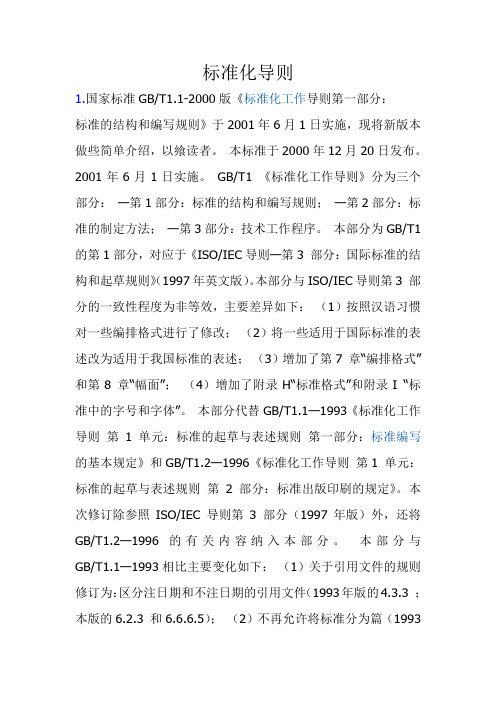
标准化导则1.国家标准GB/T1.1-2000版《标准化工作导则第一部分:标准的结构和编写规则》于2001年6月1日实施,现将新版本做些简单介绍,以飨读者。
本标准于2000年12月20日发布。
2001年6月1日实施。
GB/T1 《标准化工作导则》分为三个部分:—第1部分:标准的结构和编写规则;—第2部分:标准的制定方法;—第3部分:技术工作程序。
本部分为GB/T1的第1部分,对应于《ISO/IEC导则—第3 部分:国际标准的结(1997年英文版)。
本部分与ISO/IEC导则第3 部构和起草规则》分的一致性程度为非等效,主要差异如下:(1)按照汉语习惯对一些编排格式进行了修改;(2)将一些适用于国际标准的表述改为适用于我国标准的表述;(3)增加了第7 章“编排格式”和第8 章“幅面”;(4)增加了附录H“标准格式”和附录I “标准中的字号和字体”。
本部分代替GB/T1.1—1993《标准化工作导则第 1 单元:标准的起草与表述规则第一部分:标准编写的基本规定》和GB/T1.2—1996《标准化工作导则第1 单元:标准的起草与表述规则第 2 部分:标准出版印刷的规定》。
本次修订除参照ISO/IEC导则第3 部分(1997年版)外,还将GB/T1.2—1996的有关内容纳入本部分。
本部分与GB/T1.1—1993相比主要变化如下:(1)关于引用文件的规则修订为:区分注日期和不注日期的引用文件(1993年版的4.3.3 ;本版的6.2.3 和6.6.6.5);(2)不再允许将标准分为篇(1993年版的5.3.2 );(3)对标准要素的划分进行了调整,分为“规范性要素”和“资料性要素”(1993年版的4.1 ;本版的5.1.3),并对其他相关措辞进行相应变动;(4)按条文中提及附录的先后次序编排附录的顺序(1993年版的4.4.8、4.5.1、和5.3.6 ;本版的5.2.6、6.3.8、和6.4.1);(5)参考文献不再作为附录,而是作为与附录不同的要素(1993年版的4.3.3 ;本版的6.4.2);(6)条文的注不再允许全文连续编号(1993年版的4.5.3 ;本版的6.5.1);(7)增加了示例的表述规则(见6.5.1);(8)图和表的注不可以包含要求(1993年版的4.5.4;本版的6.6.4.8和6.6.5.6);(9)图和表的脚注可以包含要求(1993年版的4.5.2;本版的6.6.4.9和6.6.5.7);(10)修改了数学公式的内容(1993年版的6.6.1;本版的6.6.9);(11)增加了标准的编排格式,简化了首页格式并调整了标准其他内容的格式(见第7 章);(12)增加了对标准幅面的规定(见第8 章);(13)修改了术语和定义的起草和表述的附录(1993年版的附录B;本版的附录C);(14)增加了资料性附录“标准中使用的量和单位”(见附录F);(15)增加了规范性附录“标准格式”(见附录H);(16)增加了规范性附录“标准中的字号和字体”(见附录I)。
危险化学品事故应急救援预案编制导则(二篇)
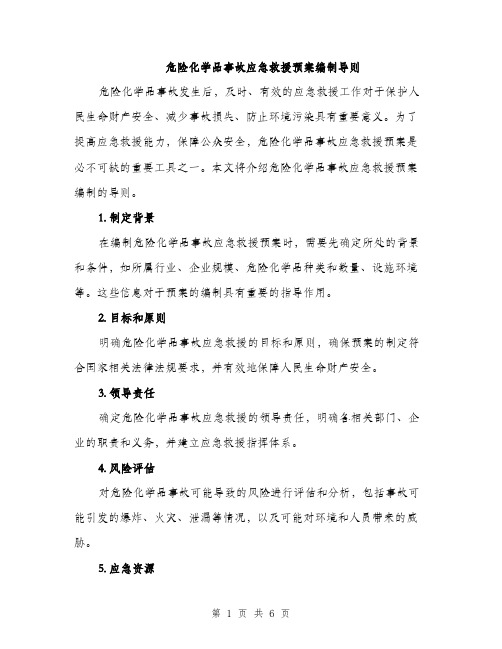
危险化学品事故应急救援预案编制导则危险化学品事故发生后,及时、有效的应急救援工作对于保护人民生命财产安全、减少事故损失、防止环境污染具有重要意义。
为了提高应急救援能力,保障公众安全,危险化学品事故应急救援预案是必不可缺的重要工具之一。
本文将介绍危险化学品事故应急救援预案编制的导则。
1. 制定背景在编制危险化学品事故应急救援预案时,需要先确定所处的背景和条件,如所属行业、企业规模、危险化学品种类和数量、设施环境等。
这些信息对于预案的编制具有重要的指导作用。
2. 目标和原则明确危险化学品事故应急救援的目标和原则,确保预案的制定符合国家相关法律法规要求,并有效地保障人民生命财产安全。
3. 领导责任确定危险化学品事故应急救援的领导责任,明确各相关部门、企业的职责和义务,并建立应急救援指挥体系。
4. 风险评估对危险化学品事故可能导致的风险进行评估和分析,包括事故可能引发的爆炸、火灾、泄漏等情况,以及可能对环境和人员带来的威胁。
5. 应急资源明确危险化学品事故应急救援的资源需求,包括人员、设备和物资,并建立相应的储备体系。
同时,需要与相关单位进行合作,充分利用外部资源。
6. 应急预警建立危险化学品事故应急预警机制,确保及时获取事故相关信息,并及时向相关部门发出预警信息,以便快速启动应急救援工作。
7. 应急组织建立危险化学品事故应急组织机构,明确各职能部门的任务和职责,并制定相应的工作流程和协调机制,以确保救援工作的有序进行。
8. 应急演练定期组织危险化学品事故应急演练,包括实地演练和桌面模拟演练,以提高应急救援能力和熟悉应急预案的操作流程。
9. 经验总结及时总结应急救援工作的经验和教训,不断改进和完善应急预案,提高应急救援的效率和质量。
10. 宣传教育加强危险化学品事故应急救援的宣传教育,提高公众的应急意识和自防自救能力,以减轻事故对公众的影响。
以上是危险化学品事故应急救援预案编制的一般导则,具体编制过程需要结合实际情况进行细化和完善。
应急管理部2个导则宣贯培训,危险化学品企业安全风险隐患排查治理导则,化工园区安全风险排查治理导则

国家相关法律、法规、规章及标准,制定本导则。
11
1.2 本导则适用于危险化学品生产、经营、使用发证企业(以下简称企业)
的安全风险隐患排查治理工作,其他化工企业参照执行。
1.3 安全风险是某一特定危害事件发生的可能性与其后果严重性的组合;全
风险点是指存在安全风险的设施、部位、场所和区域,以及在设施、部位、
安全生产。
2.2 企业应建立健全安全风险隐患排查治理工作机制,建立安全风险隐患
11
排查治理制度并严格执行,全体员工应按照安全生产责任制要求参与安
全风险隐患排查治理工作。
2.3 企业应充分利用安全检查表(SCL)、工作危害分析(JHA)、故障类型
12
和影响分析(FMEA)、危险和可操作性分析(HAZOP)等安全风险分析方 法,或多种方法的组合,分析生产过程中存在的安全风险;选用风险评估
3 安全风险隐患排查方式及频次
3.2.2 当发生以下情形之一时,应根据情况及时组织进行相关专业性排查: (1)公布实施有关新法律法规、标准规范或原有适用法律法规、标准规范重新修订的; (2)组织机构和人员发生重大调整的; (3)装置工艺、设备、电气、仪表、公用工程或操作参数发生重大改变的; (4)外部安全生产环境发生重大变化的; (5)发生安全事故或对安全事故、事件有新认识的; (6)气候条件发生大的变化或预报可能发生重大自然灾害前。
企业存在以下情况的,属地应急管理部门应依法暂扣或吊销安全生产许可证:
01 主 要 负 责 人 、 分 管 安 全 负 责 人 和 安 全 生 产 管 理 人 员 未 依 法 取 得 安 全 合 格 证 书 。
02 涉 及 危 险 化 工 工 艺 的 特 种 作 业 人 员 未 取 得 特 种 作 业 操 作 证 、 未 取 得 高 中 或 者 相 当于高中及以上学历。
燃气服务导则 修订
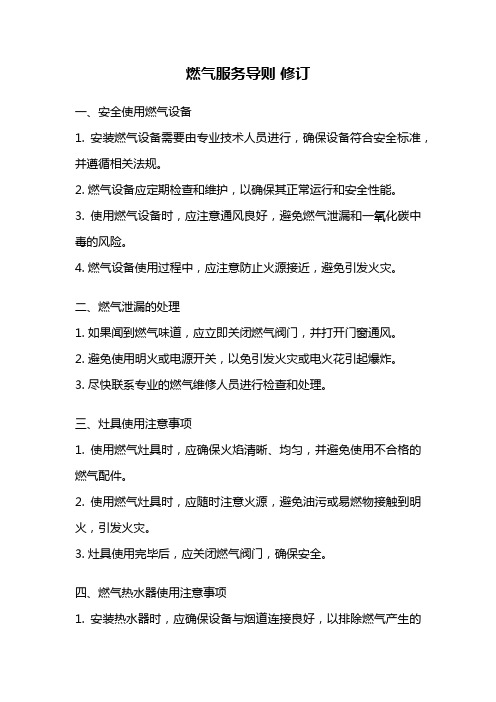
燃气服务导则修订一、安全使用燃气设备1. 安装燃气设备需要由专业技术人员进行,确保设备符合安全标准,并遵循相关法规。
2. 燃气设备应定期检查和维护,以确保其正常运行和安全性能。
3. 使用燃气设备时,应注意通风良好,避免燃气泄漏和一氧化碳中毒的风险。
4. 燃气设备使用过程中,应注意防止火源接近,避免引发火灾。
二、燃气泄漏的处理1. 如果闻到燃气味道,应立即关闭燃气阀门,并打开门窗通风。
2. 避免使用明火或电源开关,以免引发火灾或电火花引起爆炸。
3. 尽快联系专业的燃气维修人员进行检查和处理。
三、灶具使用注意事项1. 使用燃气灶具时,应确保火焰清晰、均匀,并避免使用不合格的燃气配件。
2. 使用燃气灶具时,应随时注意火源,避免油污或易燃物接触到明火,引发火灾。
3. 灶具使用完毕后,应关闭燃气阀门,确保安全。
四、燃气热水器使用注意事项1. 安装热水器时,应确保设备与烟道连接良好,以排除燃气产生的有害气体。
2. 使用热水器时,应确保燃气阀门开启,并按照说明书正确操作,避免热水器爆炸的风险。
3. 热水器使用完毕后,应关闭燃气阀门,避免燃气泄漏。
五、燃气管道安全使用1. 燃气管道安装和维修应由专业人员进行,确保管道连接牢固,防止燃气泄漏。
2. 定期检查燃气管道,确保无老化、破损等情况,及时更换或修复。
3. 在施工或装修期间,应避免损坏燃气管道,避免引发安全事故。
六、燃气应急处理1. 燃气事故发生时,应立即切断燃气阀门,并通知相关维修人员进行处理。
2. 遇到燃气事故时,应迅速疏散人员,避免造成更大的伤害。
3. 在燃气泄漏或事故发生时,切勿使用明火、电器开关等可能引发火灾的物品。
七、培养正确的燃气使用习惯1. 使用燃气设备时,应遵循正确的操作方法,不得擅自改变设备结构或使用方式。
2. 定期清洁和维护燃气设备,保持设备的正常工作状态。
3. 加强燃气安全知识的学习,提高对燃气使用的认知和安全意识。
燃气服务导则修订的目的是为了确保用户在使用燃气设备时的安全和便利。
2用电安全导则
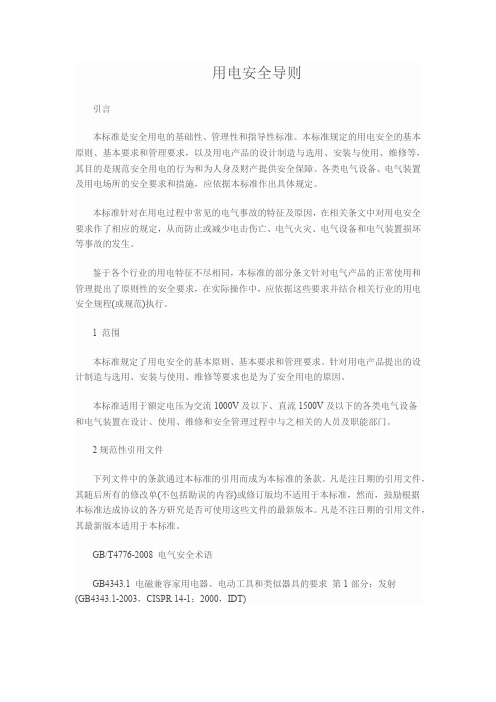
用电安全导则引言本标准是安全用电的基础性、管理性和指导性标准。
本标准规定的用电安全的基本原则、基本要求和管理要求,以及用电产品的设计制造与选用、安装与使用、维修等,其目的是规范安全用电的行为和为人身及财产提供安全保障。
各类电气设备、电气装置及用电场所的安全要求和措施,应依据本标准作出具体规定。
本标准针对在用电过程中常见的电气事故的特征及原因,在相关条文中对用电安全要求作了相应的规定,从而防止或减少电击伤亡、电气火灾、电气设备和电气装置损坏等事故的发生。
鉴于各个行业的用电特征不尽相同,本标准的部分条文针对电气产品的正常使用和管理提出了原则性的安全要求,在实际操作中,应依据这些要求并结合相关行业的用电安全规程(或规范)执行。
1 范围本标准规定了用电安全的基本原则、基本要求和管理要求。
针对用电产品提出的设计制造与选用、安装与使用、维修等要求也是为了安全用电的原因。
本标准适用于额定电压为交流1000V及以下、直流1500V及以下的各类电气设备和电气装置在设计、使用、维修和安全管理过程中与之相关的人员及职能部门。
2 规范性引用文件下列文件中的条款通过本标准的引用而成为本标准的条款。
凡是注日期的引用文件,其随后所有的修改单(不包括勘误的内容)或修订版均不适用于本标准,然而,鼓励根据本标准达成协议的各方研究是否可使用这些文件的最新版本。
凡是不注日期的引用文件,其最新版本适用于本标准。
GB/T4776-2008 电气安全术语GB4343.1 电磁兼容家用电器、电动工具和类似器具的要求第1部分:发射(GB4343.1-2003,CISPR 14-1:2000,IDT)GB4343.2 电磁兼容家用电器、电动工具和类似器具的要求第2部分:抗扰度产品类标准(GB4343.2-1999,idt CISPR 14-2:1997)GB4824 工业、科学和医疗(ISM)射频设备电磁骚扰特性限值和测量方法(GB4824-2004,CISPR 11:2003,IDT)GB16895.21-2004建筑物电气装置第4-41部分:安全防护电击防护(IEC60364-4-41:2001,IDT)GB16895.24-2005 建筑物电气装置第7-710部分:特殊装置或场所的要求医疗场所(IEC60364-7-710:2002,IDT)GB19517-2004 国家电气设备安全技术规范3 术语和定义GB/T4776-2008、GB16895.21-2004、GB19517-2004中确立的术语和定义适用于本标准。
- 1、下载文档前请自行甄别文档内容的完整性,平台不提供额外的编辑、内容补充、找答案等附加服务。
- 2、"仅部分预览"的文档,不可在线预览部分如存在完整性等问题,可反馈申请退款(可完整预览的文档不适用该条件!)。
- 3、如文档侵犯您的权益,请联系客服反馈,我们会尽快为您处理(人工客服工作时间:9:00-18:30)。
接地装置工频参数(状况评估和验收测试)测量导则修订稿1、主体内容与适用范围1.0.1本导则规定了电力系统中发电厂、变电所、输电线路杆塔的接地装置的工频参数(状况评估和验收测试)测试的一般原则、内容、方法、判据、周期。
1.0.2本导则适用于已运行的接地装置的状况评估测试,新建电厂、变电所和线路杆塔的接地装置的验收试验,独立的通讯和大型建筑的接地装置的状况评估和验收测试可参照有关内容进行。
2、引用标准下列标准所包含的条文,通过在本标准中引用而构成为本标准的条文。
本标准出版时,所示版本均为有效。
所有标准都会被修订,使用本导则的各方应探讨使用下列标准最新版本的可能性。
GB/T 17949.1-2000 接地系统的土壤电阻率、接地阻抗和地面电位测量导则-第1部分:常规测量DL/T 5091-1999 水力发电厂接地设计技术导则3、定义本导则采用下列定义:3.0.1 接地体:埋入地中并直接与大地接触的金属导体,称为接地体。
3.0.2 接地线引下线:电力设备应接地的部位与地下接地体或中性线之间的金属导体,称为接地引下线。
3.0.3 接地装置:接地体与接地引下线的总和,称为接地装置。
3.0.4 大型接地装置:110kV及以上电压等级变电所的接地装置,装机容量在200MW以上的火电厂和水电厂的接地装置,或者等效平面面积在5000m2以上的接地装置。
3.0.5 接地阻抗:接地装置对电位零点的阻抗称为接地阻抗,主要为阻性分量。
数值上为接地装置与电位零点间的电位差,与通过接地装置流入地中的电流的比值。
按通过接地装置流入地中的冲击电流得到的接地阻抗称为冲击接地阻抗;按通过接地装置流入地中工频电流求得的接地阻抗称为工频接地阻抗。
凡本导则未标明为冲击接地阻抗的,都是指工频接地阻抗。
3.0.6 电气完整性(电气导通)测试:检验接地装置的各个部分之间的电气完整性,即应该接地的各种电气设备之间,接地装置的各部分及与各设备之间的电气连接性的测试,称为电气完整性测试,也叫电气导通测试。
3.0.7 场区电位分布曲线:当接地短路电流流过接地装置时,大地表面形成电位分布,描述接地装置所在的场区这种地表电位分布状况的曲线称为场区电位分布曲线。
3.0.8 跨步电势:当接地短路电流流过接地装置时,地面上水平距离为0.8m的两点间的电位差,称为跨步电势。
3.0.9 视在跨步电势:场区电位分布曲线上间距0.8~1.0m的两点间的,经最大故障电流和试验电流折算的电位差称为视在跨步电势。
3.0.10 接触电势:当接地短路电流流过接地装置时,在地面上距设备水平距离0.8m处与沿设备外壳、架构或墙壁离地面的垂直距离1.8m处两点间电位差,称为接触电势。
3.0.11 转移电位:当接地短路电流流过接地装置时,由一端与接地装置连接的金属导体传递的接地装置对地电位称为转移电位。
3.0.12 接地装置的工频特性参数:接地装置的接地阻抗、电位分布、接触电势、跨步电势、转移电位等参数或指标,统称为接地装置的工频特性参数。
3.0.13 主地网:一个接地装置中最可靠接地的,面积最大,设备最多的接地网部分。
4、接地装置工频参数测试及评价(状况评估和验收试验)的基本原则4.1大型接地装置的状况评估和验收测试应该包含以下内容:电气完整性测试,接地阻抗测试,场区电位分布测试,接触电势、跨步电势及转移电位的测试,接地装置热容量校验,以及接地装置腐蚀状况评价。
在其它接地装置的状况评估和验收测试中应尽量包含以上内容。
4.2 接地装置的状况评价和工程验收应根据各项指标,并结合当地情况和以往的运行经验综合判断,不宜不计代价地片面强调某一项指标。
总体原则是接地装置电气完整性良好,场区电位分布均匀,接地阻抗足够小,接地装置热容量足够大,或达到设计要求。
4.3接地装置的电气完整性测试应每年进行一次;接地阻抗、场区电位分布、跨步电势、接触电势、接触电势、转移电位等工频特性参数,正常情况下可5年测试一次;遇有接地装置改造或其它必要时,应进行针对性测试;当系统容量有明显改变时,应及时校验接地装置的热容量。
4.4一般情况下应采用本导则推荐的方法进行接地装置的状况评估和验收测试,如在实际测试中遇到困难,可由有关单位负责人决定采用行之有效的方法测量。
5、地装置的电气完整性测试5.1 接地装置的电气完整性测试,就是测试接地装置的各部分和各设备之间的电气连接性,即直流电阻值。
5.2首先选定一个很可能与主地网连接良好的设备的接地引下线为参考点,再测试周围电气设备接地部分与参考点之间的直流电阻。
如果开始即有很多设备测试结果不良,宜考虑更换参考点。
5.3 测试最好选用专门仪器,仪器的分辨率为1mΩ,准确度不低于1.0级。
也可借鉴直流电桥的原理,在被试电气设备的接地部分与参考点之间加直流电流1A,再用高内阻电压表测试由该电流在参考点通过接地体到被试设备的接地部分这段金属导体上产生的电压降,并换算到电阻值。
采用其它方法时应注意扣除测量引线的电阻。
5.4状况优秀的设备测试值应在50mΩ以下;50~200mΩ的设备状况尚可,宜在以后例行测试中重点关注其变化,重要的设备宜在适当时候检查处理;200mΩ~1Ω的设备状况不佳,对重要的设备应尽快检查处理,其它设备宜在适当时候检查处理;1Ω以上的设备与主地网未连接,应尽快检查处理;独立避雷针的测试值应在500mΩ以上;测试中相对值明显高于其它设备,而绝对值又不大的,按状况尚可对待。
5.4 测试中应注意减小接触电阻的影响。
当发现测试值在50mΩ以上时,应反复测试验证。
5.5 对变电所的接地装置电气完整性测试内容,应涵盖各个电压等级的场区之间;各高压和低压设备之间,包括构架、分线箱、汇控箱、电源箱等;主控及内部各接地干线,场区内和附近的通讯及内部各接地干线,独立避雷针及微波塔与主地网之间;以及其它必要部分与主地网之间。
5.6 水电厂接地装置的电气完整性测试内容,除变电所内容同上,还应测试其它局部地网与主地网之间;厂房与主地网之间;各发电机单元与主地网之间;每个单元内部包括发电机层、水轮机层、涡壳层、网控、配电室、附属设备等;大坝,避雷针,油库,以及其它必要的部分与主地网之间。
5.7 火电厂接地装置的电气完整性测试内容,除变电所内容同上,还应测试其它局部地网与主地网之间;厂房与主地网之间;各发电机单元与主地网之间;每个发电机单元内部包括发电机及其附属设备、网控、母线室、配电室;水塔、烟囱、氢站、油库、化学,以及其它必要的部分与主地网之间。
6、接地装置工频特性参数的测试6.1 接地装置工频特性参数测试的基本要求6.1.1 接地装置的工频特性参数与土壤的潮湿程度密切相关,因此接地装置的状况评估和验收测试应尽量在干燥季节进行;不应在雨、雪中或雨、雪后立即进行,而应在连续天晴至少2天后进行。
6.1.2 为减少对电力系统正常运行的干扰,消除测试中不确定的危险因素,简化试验设备,提高测试准确度,推荐优先采用异频小电流法测试接地装置的工频特性参数,试验电流宜在3~10A,频率在40~60Hz范围,异于工频又尽量接近工频,且仪器设备附和的要求。
6.1.3 如果采用工频电流测试接地装置的工频特性参数,则应采用独立电源或经隔离变压器供电,并尽可能加大试验电流,试验电流不宜小于10A(50A),且测量仪器附和要求。
6.1.4测量接地装置工频特性参数的电极应布置得尽量远,参见图1,通常电流辅助极距被试地网边缘的距离d CG应为被试地网等效直径D的4~5倍;对超大型的接地装置的测试,可考虑利用架空线路做测试电流线和电位线;当远距离放线有困难时,在土壤电阻率均匀地区可取2D;在土壤电阻率不均匀地区可取3D。
6.1.5 接地装置的工频参数的测量回路应尽量避开河流、湖泊,尽量避免与地下金属管路长段并行,尽量接近输电线路接地短路时的测量回路,尽量避免电流线与电位线之间的互感的影响。
6.1.6 电流辅助极的接地电阻应尽量小,以保证整个电流回路阻抗足够低。
可采用10根左右1.5m长的1.2寸铁管,以2m左右间距楔入地中,并联起来作为电流辅助极;也可以利用高压输电线路的铁塔作为电流辅助极,但应注意输电电流对试验的干扰。
电位测试极即铁钎紧密而不松动地插入土壤中。
6.1.7大型接地装置工频特性参数测试时,试验电流的注入点宜选择单相接地短路电流大的场区里,电气导通测试中结果良好的设备接地引下线处。
小型接地装置的测试可根据具体情况参照进行。
6.2 接地阻抗的测试6.2.1 接地阻抗是接地装置的一个重要参数,但并不是唯一的、绝对的参数指标,它概要性地反映了接地装置的状况,而且与接地装置的面积和所在地的地质情况有密切的关系。
因此判断接地阻抗的是否合格,首先要参照“DL/T 621-1997交流电气装置的接地”中的有关规定,另外要根据实际情况,包括地形、地质和接地装置的大小,综合判断。
6.2.2 大型接地装置的接地阻抗应采用电位降法或电流-电压表法测试,小型接地装置的接地阻抗可采用电流-瓦特表法或接地摇表测试。
6.2.3 接地阻抗的测试无论采用哪种方法,都应考虑避雷线及引外的金属管路如电厂的除灰管、供水管等对试验电流分流的的影响。
分流的测试可采用高精度罗可夫斯基线圈,逐个测试与接地装置相连的避雷线和引外的金属管路的分流,相加得总的分流I F。
6.2.4 接地阻抗的测试方法6.2.4.1 电位降法测试接地阻抗电位降法测试接地装置的接地阻抗即是按图1布置测试回路:流过被试接地装置G 和电流辅助极C 的电流I 使地面电位变化,电位极P 从G 的边缘开始沿与电流回路呈30°~45°的方向向外移动,每间隔d (50m或100m )测试一次P 与G 之间的电位差V ,绘出V 与x 的变化曲线,如图2:图2:电位降曲线曲线平坦处,即电位零点,与曲线起点间的电位差即为在试验电流下被试接地装置的电位升高U ,再考虑分流的影响,接地装置的接地阻抗Z 有: Z U I I F=- (1) 如果电位测试线与电流线呈角度放设确实困难,可与之同路径放设,但要保持尽量远的距离。
如果电位降曲线的平坦点难以确定,则可能是受被试接地装置或电流极C 的影响,考虑延长电流回路;或者是地下情况复杂,考虑以其它方法来测试和校验。
6.2.4.2 电流-电压表法测试接地阻抗6.2.4.2.1 电流-电压表三极法测接地阻抗三极法测试接地阻抗的接线图见图3。
d CG 如6.1.4的要求,d PG 通常为0.5~0.6倍d CG 。
501001502002503003501234567¾à主网距离£¨百米)电位降(m V £©如果电流线和电位线任意夹角布线,接地阻抗可用公式(2)修正。
